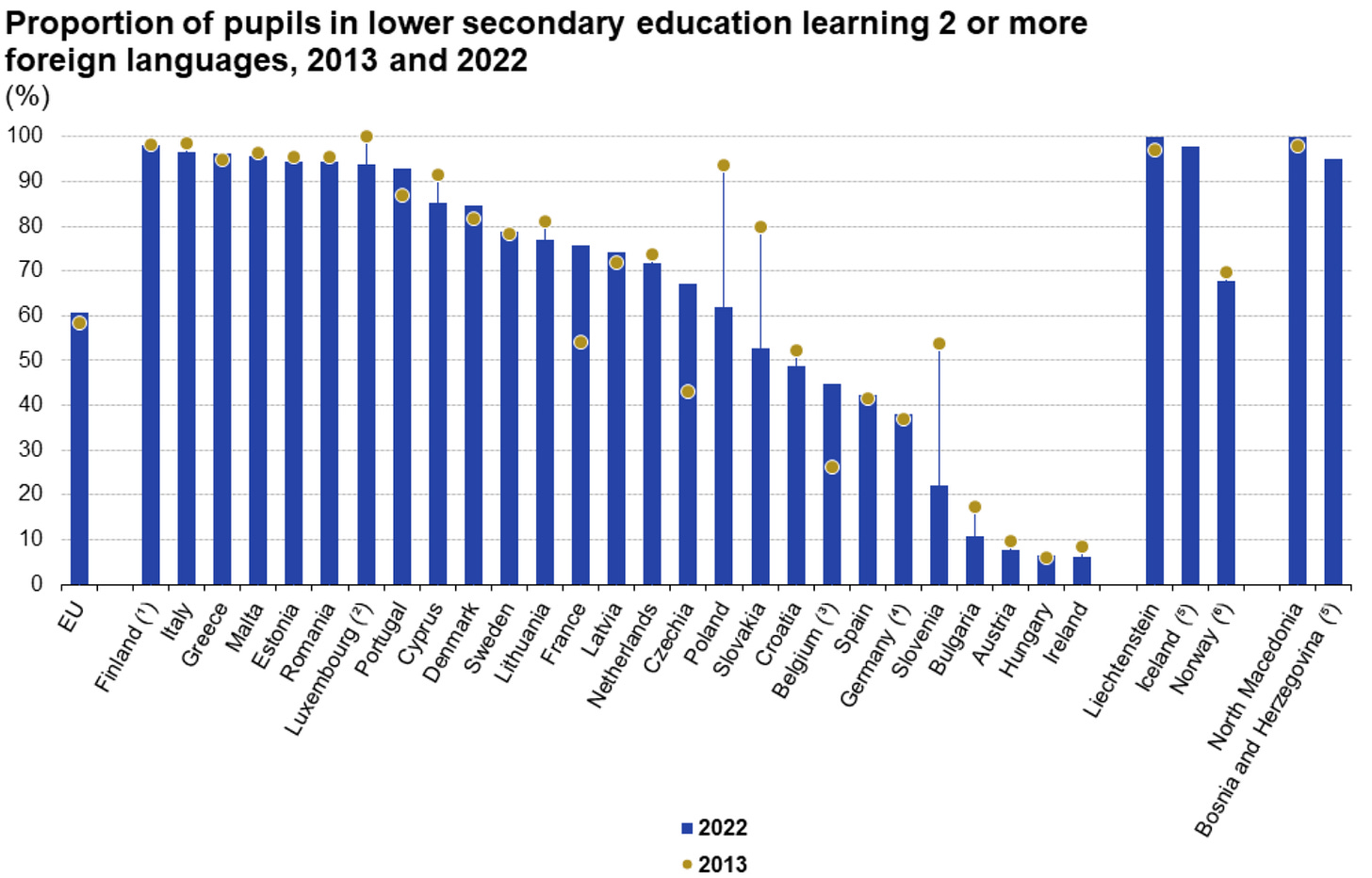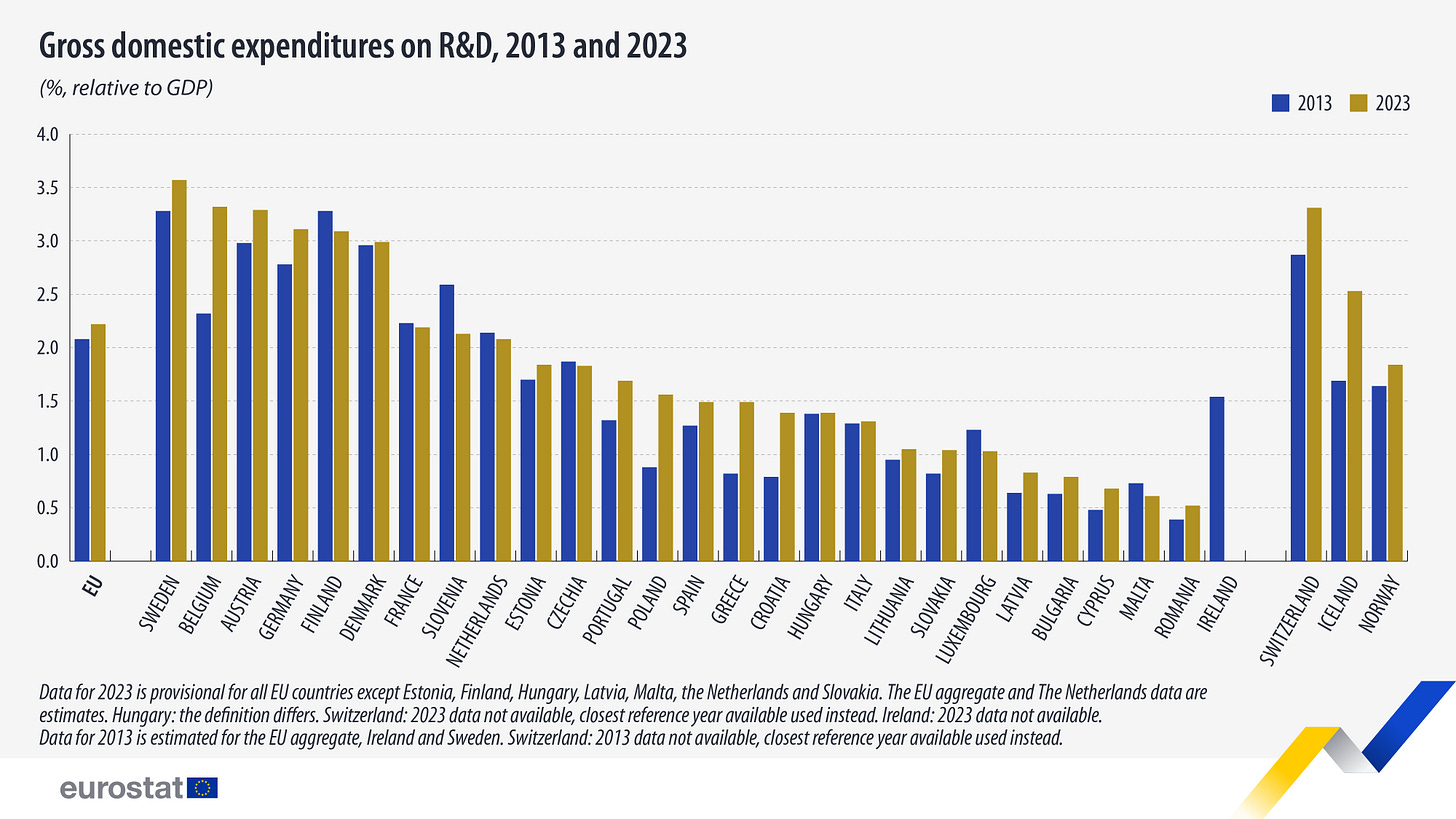Greece's education in 7 numbers
A quick glimpse into Greece's education landscape
Welcome to the 74 awesome new readers who joined us in the past week!
If you haven’t subscribed, join 3,089 smart, curious people interested in Changing Greece.
🎓 Greece's education in 7 numbers
I care a lot about the quality of education in Greece.
“It is the alpha and the omega of everything”, as we tend to say in Greek.
There are just so many different aspects of it that require our attention and significantly more funding from the state.
While impossible to touch on all of them, there are a few data points we should definitely have in mind when talking about the state of Greek education.
Here are the 7 most interesting numerical facts on the matter.
45% of young Greeks have completed tertiary education
Tertiary education — also known as higher education, or post-secondary education — is the educational level that comes after high school. It includes universities, colleges, and vocational schools.
In 2023, almost 45% of Greeks aged 25-34 had successfully graduated from tertiary education programs. This is a decent number, considering 45% also represents one of the key milestones the EU has set for the entire group to pass by 2030.

Greece has done considerable progress here. In 2000, only 24% of Greeks in the same age group had attained tertiary education in the country (almost half that of today).
Zooming out, we see that Greece is somewhere in the lower middle of the OECD range for tertiary education attainment. Not great, but not terrible either.
Less than 4% of Greeks cut their schooling short
Greece has the third lowest number of early leavers from education and training in the EU, just shy of 4%.
That’s a pretty great feat, considering that the EU average is almost 10%.

Why does this matter? Because it shows that only a very small portion of Greek students end up not finishing their studies.
Greece performs below average across all PISA categories
If you’re reading this, you’ve probably heard about PISA at some point in your life.
PISA stands for the Programme for International Student Assessment. What PISA does is it assesses the knowledge and skills of 15-year-old students in mathematics, reading and science, and then compares their levels across time and countries.
Unfortunately, Greece’s PISA performance has been abysmal.

Since 2008-09, Greek students have been consistently performing worse across all segments (reading, mathematics and science) and diverging from the OECD average.
This is a not a problem unique to Greece — if you look at other countries, you will see similar downward trends. One can even say that test scores do not always correspond to real learning per se.
However, the size of the problem seems particularly acute in our country, and the cross comparative nature of our low rankings should make us (at the very least) alert about diving deeper into the problem.
The most unfortunate part? This is an endemic problem for Greece. It does not matter if students come from a higher socio-economic background or lower, they all perform significantly worse compared to their peers from abroad.

This should be a key priority area for any Greek government to tackle.
95% of Greek students learn two or more foreign languages
Perhaps because of our high reliance on tourism as a country, Greek students have started becoming multi-lingual from a very early age.
More than 95% of Greek pupils in lower secondary education learn two or more foreign languages. That’s a pretty high number when the EU average is just over 60%.

And it’s not just English (99%) It’s also French (47.5%) and German (47.1%).
While the proportion of native Greeks in the country that are also fluent English speakers is not very high, there is a minor percentage of the population that cannot maintain a basic conversation in English with foreigners.
I find this pretty amazing.
Teachers in Greece make almost half the OECD average
Teachers in Greece are severely underpaid.
This is true across all categories, from new teachers (for minimum qualifications) to very experienced ones (with maximum qualifications).
If we compare starting salaries for Greek teachers to other countries, we see that they are almost half the OECD average (in USD and PPP standards).

This is a big problem because it makes it difficult for great educators to become and also remain employed as teachers, especially in the public sector.
Interestingly, Greece also has the lowest student-to-teacher ratio across the EU.
Greece should invest more in the shapers of our country’s future.
Greek universities rank very low in global rankings
No matter what global list of university rankings we look at, and despite the high level of talented professors in them, Greek institutions sadly always rank exceptionally low.
According to the QS World University Rankings for 2024, the best Greek university — in this case, the National Technical University of Athens (NTUA) — is ranked 347th in the world.

According to another prestigious list, the Scrimago Institutions Rankings, Greece’s top ranked university is the University of Athens (UoA) ranked at 577th place.

These are many other lists, but the situation is not much better in any of them.
R&D expenditure has risen 2.3x times in a decade
From 2013 and 2023, Research & Development (R&D) expenditure increased from €1.5 to €3.4 billion — an increase of almost 2.3x.
At the same time, total R&D expenses as % of GDP have risen from 0.8% to 1.5%.
While still below the EU average of 2.2%, this has been a significant jump for Greece, which had one of the largest increases in Europe and is now coming much closer to the center of the EU-wide distribution.

🏭 Economy & Business
Domestic bank deposits up €2.5b in December, surpassing €150b in 2024
Household wealth reaches €963b in 2024, up 40% since 2020
Greek stock market reached 1,557 points, marking a 14-year high
Exports rose 7.8% in December but fell 2% year-on-year in 2024
Multinationals are opening offices to Greek cities outside Athens
THEON remains one of Greece’s top defense and exporting companies
Titan debuts on the New York Stock Exchange, rings opening bell
🤖 Tech & Startups
Greek tech ecosystem boasts at least 400 startup jobs across 90 companies
Comulate (insurance automation) raised $20M in Series B funding
Keragon (AI healthcare) announced its $7.5M seed round
Akina (AI healthcare) raised a $3.1M in seed round
Robenso (environmental robotics) raised €0.5M in pre-seed funding
Greek founded startups started the year by raising $28M in January 2025
Open Coffee Athens hosted the founders of Phylax, Flexciton and Pollfish
Yiannis Kiachopoulos from Causaly invited at 10 Downing Street to talk AI
Piraeus Startup Accelerator has just kicked off in early February
🙌 Celebrating Greek wins
Christina Delimitrou (MIT) receives prestigious Presidential Early Career Award, and together with Christos Kozyrakis (Stanford), they also recently received the 2024 ASPLOS Influential Paper Award for their now industry famous 2014 paper
Odysseas Theodoratos received the 1st World Webtoon Foreign Creator Award for his extraordinary manga TOMAHAWK ANGEL
Vasileios Tsianos single-handedly saving the West’s strategy for rare earth metals
Melina Travlos remains at helm of the Union of Greek Shipowners for a 2nd term
Τheodosis Kontopoulos brought Broadway quality to the Greek theater scene
📌 Spotlight: Lessons from top Greek entrepreneur
This is an absolute must watch conversation between George Hadjigeorgiou (co-founder of e-food and Zoe) and Kyriakos Eleftheriou (founder of Terra API).
Many golden nuggets shared here by George from his experience as one of Greece’s most successful entrepreneurs.
That’s it for today! If you enjoyed today’s newsletter, please let me know with a like or reply. This helps me focus more on topics that are useful to my readers.
Find me on X or Bluesky for bite-sized opinions.
Until next time!







A very interesting read, with thanks for putting together.
A glaring observation from these statistics is that the first two % (tertiary education completion rate & early leavers) unfortunately appear to be completely pointless irl. This seems to be the conclusion that’s drawn (or at least that I drew, correctly or not) from when one takes into account the PISA stat.
While university level education completion rate is a ‘marketable’ metric, the fact that the educational level of 15yo students is low probably means that the standards for university admissibility are also quite low (e.g. if Greek 18yos were ‘competing’ against Esthonian or Japanese 18yos for the same university spots, Greeks would obviously not be admitted - with the first % spiraling down..)
It then stands to reason that the quality of tertiary studies is also not very high either (otherwise we wouldn’t have a high tertiary education completion %..), which if correlated with the underpayment of teachers (albeit I’m not sure whether those stats relate to teaches in secondary education or lower or whether they also capture uni level lecturers) tracks.
In any event, a very interesting read as I said + a very good point in the comments re: ‘frontistiria’ (and a great topic to be explored in and of itself in a Vol. 2 perhaps).
The fact that not many students drop out of their education has to do a lot with culture I believe. At the same time it is healthy for someone to reconsider their options and choose wisely without any pressure, so the low percentage of 4% shouldn't necessarily be appraised. Moreover, as we all know R&D budgets have increased across Europe, without any potential ROI so far. I believe we need to stop and reconsider also where all that (mostly public) money should be allocated instead